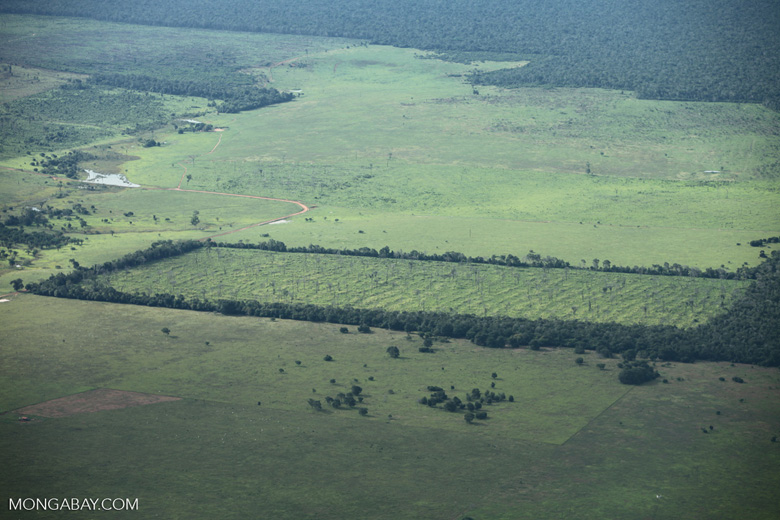- Deforestation watchdog Monitoring of the Andean Amazon Project found that 4,500 square kilometers (1,740 square miles) of the Brazilian Amazon was deforested between 2017 and 2019 and then burned.
- The team’s analysis revealed that 65 percent of that deforestation occurred in 2019 alone.
- The research points to the need for policymakers to address deforestation as well as fires.
The prevailing narrative about the Brazilian Amazon this past summer was that the world’s largest rainforest was burning. A more accurate assessment would be that vast areas that used to be forest were burning, according to work by the Monitoring of the Andean Amazon Project (MAAP), a program of the organization Amazon Conservation.
In a study published Nov. 13, the deforestation monitoring group found that 4,500 square kilometers (1,740 square miles) of the Brazilian Amazon — about 1.8 times the size of Luxembourg — was deforested between 2017 and 2019 and then burned.
“The key star of the fire season was still deforestation,” Matt Finer, senior research specialist and director of MAAP, said in an interview.
The deforestation of 1,760 hectares (4,350 acres) in Mato Grosso state in 2019 (May to July), followed by fires in August. Video courtesy of MAAP/Planet.
In September, MAAP scientists first revealed that much of the fire in the Amazon that had grabbed the world’s attention in August 2019 was occurring on recently deforested land, not in standing forests.
“We’re not seeing too many examples of a fire just appearing out of nowhere,” Finer said. “All the examples we see are of fires burning a recently deforested area. Then they escaped into surrounding forest, but they never turned into this big uncontrolled fire.”
Finer and his colleagues compared satellite forest loss data from Global Forest Watch and the University of Maryland with fire alert data from NASA. They also looked at fire data from Brazil’s National Institute for Space Research (INPE) to tease out how much deforestation occurred in 2019. Known as DETER alerts, these points identify burn scars in the forest down to 30-meter (98-foot) resolution.

Surprisingly, 2,980 square kilometers (1,150 square miles) of forest was cleared and burned in 2019, about 65 percent of the 4,500-square-kilometer area deforested between 2017 and 2019.
Their analysis also showed that more than 1,600 square kilometers (619 square miles) of primary forest burned in 2019. But Finer and his colleagues believe that most of these fires were started to clear vegetation for farms or pastures since they appear to spread outward from adjacent deforested land.
University of Maryland ecologist Matt Hansen told the Washington Post in October that the recent fires in the Amazon are far from regions where crops like soy are leading to deforestation. He said he suspects that cattle ranchers are likely using the fires to expand their grazing land.
“If you’re a big soy producer, there’s so much intensification around the larger agro-industrial farms,” Hansen told the Post, “you don’t want fire around.”
The deforestation of 650 hectares (1,600 acres) in Rondônia state in 2019 (April to July), followed by fire in August. Video courtesy of MAAP/Planet.
Fires in South America’s drier forests bear a different signature compared to those in the rainforest. (MAAP’s current analysis centered on the Amazonian states of Amazonas, Rondônia, and Pará.) In October, MAAP demonstrated that fires in the drier Chiquitanía and Chaco regions of Bolivia were tearing through large swaths of natural ecosystems.
However, that doesn’t mean that fires in the Amazon rainforest won’t ever rage out of control.
In a severe drought, Finer said, “all of a sudden, those escape fires are going to start looking more and more like we saw in the dry forest in Bolivia.
“If it’s a drier year, they could really light up the Amazon,” he added.

A recent study found that climate change and burning vegetation have caused the atmosphere over the Amazon to grow significantly drier in the past few decades, increasing the risk of fire.
Finer’s team’s research points to the need for policymakers to address deforestation as well as fires.
“[W]e need to recognize that many of the fires are in fact a lagging indicator of previous deforestation, thus to minimize fires we need to minimize deforestation,” they write.
As the risk for fire grows, Finer pointed to the need to focus on deforestation with the same intensity leveled on fires in 2019.
“How can we generate that global sense of urgency that we saw, as opposed to having hysteria every August?” he said.
Banner image of a soy plantation next to transition forest in Brazil by Rhett A. Butler/Mongabay.
John Cannon is a staff writer at Mongabay. Find him on Twitter: @johnccannon
Citation:
Finer, M. & Mamani, N. (2019). Satellites Reveal what Fueled Brazilian Amazon Fires. MAAP: 113.
FEEDBACK: Use this form to send a message to the author of this post. If you want to post a public comment, you can do that at the bottom of the page.














